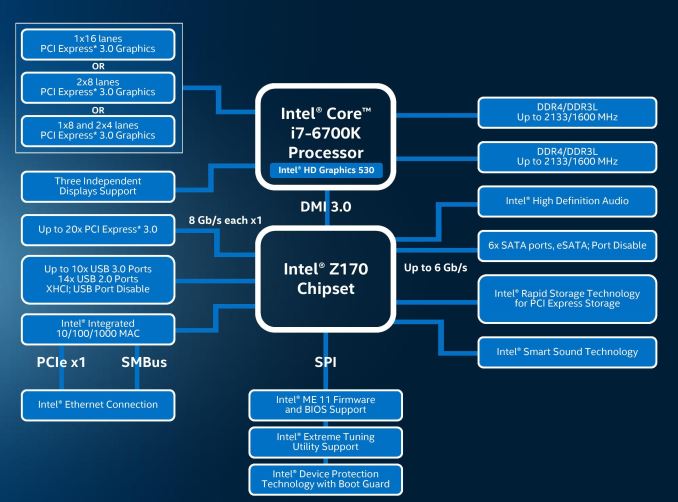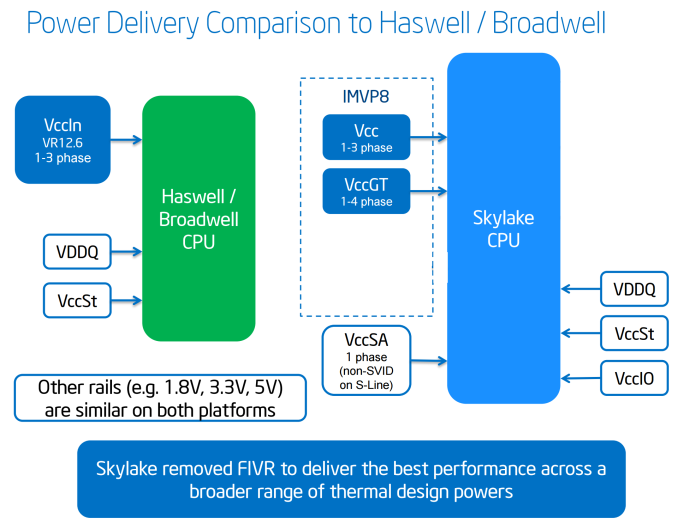The Intel 6th Gen Skylake Review: Core i7-6700K and i5-6600K Tested
by Ian Cutress on August 5, 2015 8:00 AM ESTThe Skylake CPU Architecture
As with any new Intel architecture, the devil is in the details. Previously at AnandTech we have been able to provide deep dives into what exactly is going on in the belly of the beast, although the launch of Skylake has posed a fair share of problems.
Nominally we rely on a certain amount of openness from the processor/SoC manufacturer in providing low level details that we can verify and/or explain. In the past, this information has typically been provided in advance of the launch by way of several meetings/consultations with discussions talking to the engineers. There are some things we can probe, but others are like a black box. The black box nature of some elements, such as Qualcomm’s Adreno graphics, means that it will remain a mystery until Pandora’s box is opened.
In the lead up to the launch of Intel’s Skylake platform, architecture details have been both thin on the ground and thin in the air, even when it comes down to fundamental details about the EU counts of the integrated graphics, or explanations regarding the change in processor naming scheme. In almost all circumstances, we’ve been told to wait until Intel’s Developer Forum in mid-August for the main reason that the launch today is not the full stack Skylake launch, which will take place later in the quarter. Both Ryan and I will be at IDF taking fastidious notes and asking questions for everyone, but at this point in time a good portion of our analysis comes from information provided by sources other than Intel, and while we trust it, we can't fully verify it as we normally would.
As a result, the details on the following few pages have been formed through investigation, discussion and collaboration outside the normal channels, and may be updated as more information is discovered or confirmed. Some of this information is mirrored in our other coverage in order to offer a complete picture in each article as well. After IDF we plan to put together a more detailed architecture piece as a fundamental block in analyzing our end results.
The CPU
As bad as it sounds, the best image of the underlying processor architecture is the block diagram:
From a CPU connectivity standpoint, we discussed the DDR3L/DDR4 dual memory controller design on the previous page so we won’t go over it again here. On the PCI-Express Graphics allocation side, the Skylake processors will have sixteen PCIe 3.0 lanes to use for directly attached devices to the processor, similar to Intel's previous generation processors. These can be split into a single PCIe 3.0 x16, x8/x8 or x8/x4/x4 with basic motherboard design. (Note that this is different to early reports of Skylake having 20 PCIe 3.0 lanes for GPUs. It does not.)
With this, SLI will work up to x8/x8. If a motherboard supports x8/x4/x4 and a PCIe card is placed into that bottom slot, SLI will not work because only one GPU will have eight lanes. NVIDIA requires a minimum of PCIe x8 in order to enable SLI. Crossfire has no such limitation, which makes the possible configurations interesting. Below we discuss that the chipset has 20 (!) PCIe 3.0 lanes to use in five sets of four lanes, and these could be used for graphics cards as well. That means a motherboard can support x8/x8 from the CPU and PCIe 3.0 x4 from the chipset and end up with either dual-SLI or tri-CFX enabled when all the slots are populated.
DMI 3.0
The processor is connected to the chipset by the four-lane DMI 3.0 interface. The DMI 3.0 protocol is an upgrade over the previous generation which used DMI 2.0 – this upgrade boosts the speed from 5.0 GT/s (2GB/sec) to 8.0 GT/s (~3.93GB/sec), essentially upgrading DMI from PCIe 2 to PCIe 3, but requires the motherboard traces between the CPU and chipset to be shorter (7 inches rather than 8 inches) in order to maintain signal speed and integrity. This also allows one of the biggest upgrades to the system, chipset connectivity, as shown below in the HSIO section.
CPU Power Arrangements
Moving on to power arrangements, with Skylake the situation changes as compared to Haswell. Prior to Haswell, voltage regulation was performed by the motherboard and the right voltages were then put into the processor. This was deemed inefficient for power consumption, and for the Haswell/Broadwell processors Intel decided to create a fully integrated voltage regulator (FIVR) in order to reduce motherboard cost and reduce power consumption. This had an unintended side-effect – while it was more efficient (good for mobile platforms), it also acted as a source of heat generation inside the CPU with high frequencies. As a result, overclocking was limited by temperatures and the quality of the FIVR led to a large variation in results. For Skylake on the desktop, the voltage regulation is moved back into the hands of the motherboard manufacturers. This should allow for cooler processors depending on how the silicon works, but it will result in slightly more expensive motherboards.
A slight indication of this will be that some motherboards will go back to having a large amount of multiplexed phases on the motherboard, and it will allow some manufacturers to use this as a differentiating point, although the usefulness of such a design is sometimes questionable.












477 Comments
View All Comments
DanNeely - Wednesday, August 5, 2015 - link
Reliability might start to be a concern in the next year or two. I had a 920 and a 930 (bought right after release and about a year later); but back in June the 920 stopped POSTing. Since I did a precautionary upgrade to a 4790K at the start of the year it didn't impact me; and I haven't gotten around to doing any part swaps to figure out which component failed yet. (Not so I can buy a replacement part; but so I know what's potentially usable as a spare if/when the 930 does the same.)06GTOSC - Wednesday, August 5, 2015 - link
Looks to me that I'm not missing anything for gaming by staying with my 4790k.nmm - Wednesday, August 5, 2015 - link
Well, that was a bit underwhelming. Fantastic article, of course, but I can't agree that this is a nail in the coffin for Sandy Bridge. For myself, I think I'll just upgrade the cooler on my i7 2600k and bump the multiplier up a few notches and hold out for another year. When there are some reasonably cheap NVME options and affordable/fast high capacity DDR4 modules and Pascal GPU's, that will probably be the right time for me to break up with Sandy.piroroadkill - Wednesday, August 5, 2015 - link
Definitely not the nail in the coffin for Sandy, far from it.In games, there's still no point to upgrading..
Jon Tseng - Wednesday, August 5, 2015 - link
TBH I'm not missing anything staying with my QX6850! (65nm FTW). GPU is all that matters nowadays...postem - Wednesday, August 5, 2015 - link
That was my doubt when i was up to wait 6 months or get DC to replace old 950. The difference is mainly negligible from DC, but there will be much more costly due to new mobos, DDR4 and so on.kenansadhu - Saturday, August 8, 2015 - link
Were you really thinking about upgrading to skylake when you bought your 4790k?Refuge - Wednesday, August 5, 2015 - link
I wanna know whats going on under the hood. Can't wait for the follow up article.Otherwise I'm disappointed, if you claim this is the end for Sandybridge, then anyone who agree's and is upgrading lemme know, I'll gladly take your old hardware for cheap.
With this performance I'd be happier buying a Devilscanyon for less and wait for Intel to actually give me something worth spending $220+ on.
Skylake, I am very disappoint.
otimus - Wednesday, August 5, 2015 - link
Says "Sandy Bridge, your time is up" proceeds to practically show data as to why it is not. Especially for gaming.Do you guys just not live in reality, or does getting things for free just flat out cloud your mind to the staggering cost it'd take to go from Sandy Bridge to Skylake for what seems like a very few FPS? Even worse, I imagine most folks are still on 60 Hz monitors.
Refuge - Wednesday, August 5, 2015 - link
I have a lot of respect for you Ian, but I completely disagree that Sandy's time is up, and if it is? Skylake isn't the cause. This is such a terrible release haha. I hope it is just some launch kinks that need ironed out.Otherwise Devils Canyon is where its at. Older gen so it is cheaper, and it is more compelling than this slab of silicon. Other than increased iGPU performance with DDR4 memory, there isn't a single gain I saw in any of these benchmarks that is noticeable to an end user.